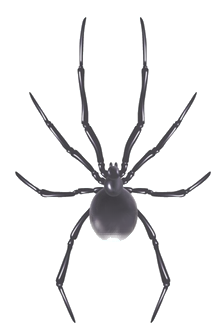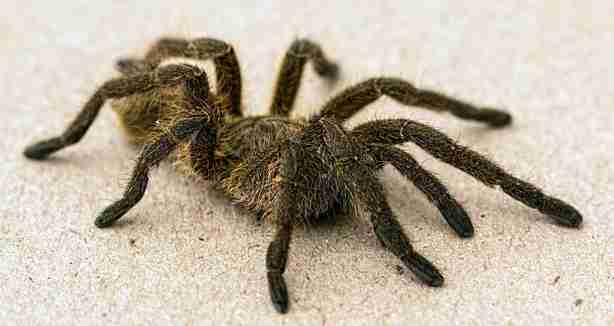The Australian funnel-web spider (Atrax robustus) is the most poisonous and dangerous spider in the world.
🕸 Atrax Robustus

The Atrax robustus is number one in the Guinness Book of Records in this regard. Its bite can even be fatal to humans within an hour. Its habitat extends within a 160 km radius of the famous opera city of Sydney, Australia. This is why the Antrax robustus is also called the Sydney funnel-web spider. The females grow up to 40 mm in size, the males up to 50 mm. A characteristic feature is their metallic, shimmering brown or black torso. The spiders also like to crawl into shoes. The venom of the males in particular is used to make an antidote. Their venom is up to six times more toxic than that of the females. There have been hardly any deaths since the 1980s.
Related to the Atrax Christenseni, which is the third species native to New Castle, Australia.
🕸 Brazilian wandering spider
The Phoneutria nigriventer, also known as the Brazilian wandering spider, lives in southeastern Brazil, northern Argentina and parts of Paraguay and Uruguay. It prefers to live in the rainforest, but occasionally appears in residential areas. The spider is considered very aggressive and its bite can be fatal. Its body length is 25 to 50 millimeters. Its leg span of up to 150 millimeters and its medium brown color are characteristic. The males are relatively smaller than the females.
🕸 Black widow
The Latrodectus or black widow belongs to the group of orb-web spiders as well as to the group of spiders. Its black color and spherical body are characteristic. The body is often covered with conspicuous red spots. Its spider toxin can also have serious consequences for humans. In the southern USA, several thousand people had to be treated for a black widow bite. Fortunately, its bite is not fatal in most cases. Black widows are found worldwide, including in Europe. The European species are considered less dangerous. Here too, the females are the larger sex, with a body size of 7.5 to 20 mm, which varies by region. The males only manage to reach 2.5 to 6.5 millimeters. The habitat of the more dangerous Latrodecutus is South America and the southern USA. The name "widow" is derived from the habit of the females killing the males after mating and often eating them. The black widow is often confused with the Australian Latrodectus hasselti (red-backed orb-weaver spider), which also came to Europe as "stowaways" during freight deliveries. But this species also belongs to the "true widows".
🕸 Chilean house spider
The six-eyed Loxosceles laeta or Chilean house spider is one of the most dangerous of its kind. Its habitat is South America, especially Chile. Its venom is also considered to be at least potentially fatal, as its toxin can cause tissue and liver damage in sufficient quantities. In the medium brown color, it is not so much the body that is striking, but rather its large wingspan. Here too, the females are larger with an average body length of 12 millimeters (males around 9 mm). With its legs outstretched, this species has a gruesome wingspan of 30 to 50 mm.
🕸 Red-headed mouse spider
The red-headed mouse spider or Missulena Occatoria releases a toxin that can cause paralysis. However, the amount of poison administered is more dangerous for small children and in rare cases fatal. Its appearance and strong-looking legs are striking. This spider also has a black coloring and a strikingly red head, which is why it is sometimes called the "red-head". Its habitat is the Australian continent. The additional name "mouse spider" is attributed to its ability to dig burrows like rodents. Its body length can be up to 25 mm with a roughly the same average wingspan.
🕸 Red Widow
The Latrodectus Bishopi or Red Widow spider, which is native to Florida/USA, is also one of the poisonous species. Since the spider prefers more rural areas and is known to be less aggressive, its toxin rarely finds human victims. In sufficient quantities, bites from this species can also be fatal to humans. Here too, the female is the larger sex. The spiders prefer sand dunes as their habitat. With a brown-reddish coloration, a wingspan of up to 60 mm can be achieved. Their black body is also spherical and has white, red and brown spots. The head and legs are brown-reddish in color. This species also kills and eats the males after mating.
🕷 There are numerous other spider species worldwide that secrete poisonous substances with their bite. The toxic effect on humans rarely goes beyond reddening of the skin or swelling. These species include
-
Nurse's thorn spider (Cheiracanthium punctorium), living in Mediterranean regions of Europe.
-
Six-eyed sand spider (Sicarius hahni), southern desert region of Africa.
-
Yellow sac spider (Cheiracanthium inclusum), North, Central and South America.
-
Recluse spider (Loxosceles reclusa), also called violin spider because of its violin-shaped body pattern. Southwestern USA.
-
and others

For most poisonous spiders, there is an antidote available in the respective countries and a bite is becoming increasingly rare and fatal.
📌 Note: Tarantulas are often portrayed as dangerous creatures in movies. It should be comforting to know that although their size makes them scary, they hardly contain any toxins that are dangerous to humans. Nevertheless, a bite can be very painful. There are countless species of the eight-eyed Theraphosidae or formerly "Aranae avicularia" (~ "bird-like spider"). The current literature also states that the name is derived from a description 300 years ago in which a scientist captured a large spider sitting on a hummingbird.
---
Rainar Nitzsche (2018). Spinnen - Biologie - Mensch und Spinne - Angst und Giftigkeit (German)
Fohlenstein, Kim (2020). Spinnen - Wundheilung der Versorgungskraft. (German)
Magazin Welt der Wunder 5/24 (2024) - Kann man Spinnen melken? S. 45. (German)
